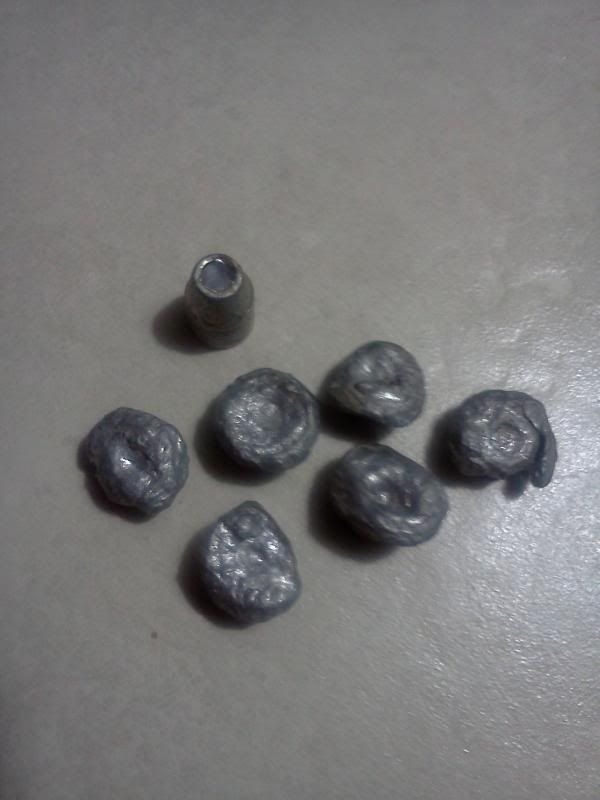wncchester wrote,
Yeah. Your nice photos show one that fragmented and I consider that a common cast HP bullet failure; the key word was 'realiably", not "sometimes" or "most of the time". Also suspect the collection of "perfect" mushrooms were saved individuals because they are perfect, not because they're typical. Kinda like "wallet" rifle groups that are saved because they're by no means typical accuracy!
Well to be honest they were saved due to being perfect, I will not deny that one ioata. However, I have plenty more of them which look almost identical as well, so they are certainly not flukes in any way, nor or they simply a dozen out of a hundred which looked good. I'm not even going to address the "wallet target" comment since that isn't part of the discussion. I will however if you want to start your own post on them though.
What you cannot seem to soak in is that some of us put in the effort and work to develope the alloy for the purpose, and the load. This isn't something that one just throws into a pot and comes up with, it takes plenty of trial and error. Most folks who cast simply don't pursue it as it isn't as easy as simply throwing some chunks of lead in the pot and pouring up solids.
If you would like to see more of them and how they were recoverd you can head over to the following link. It has more of them posted there as well as the trap in which I caught them in. Follow the link below and look for the sub folder named "Alloy Testing"
Cast Boolit Loading and Shooting
Also here is another link you might find informative as well, it somewhat goes into how I came up with the alloy I used in those pictured bullets,
Latest HP Alloy Blend
Oh and by the way, if you think that ANY factory HP rounds work equally well , as you put it, "the key word was 'realiably", not "sometimes" or "most of the time"." you really are living in some sort of fantasy world. I have been doing this sort of thing since back when I was a kid getting my pop to shoot stuff so we could get the bullets back. I have been loading my own going close to 45 years. While I cannot say that I am any sort of expert, I believe I have a handle on what constitutes a pass or fail, and I certainly wouldn't call any of the bullets made with that particular alloy a failure. They all look in one way form or fashion identical to what I have posted. Have I blown the noses off any, absolutely. I have driven the alloy beyond the limits of its ablity to not only hold together, but also to hold the rifling. As mentioned it is a balancing act, that most do not feel they want to work on.
As for the one posted by Rangefinder which DID break apart, While I do not feel it was perfect, it certainly wasn't a failure. IF anything, all that need be done is to identify the actual content of the alloy and bring the tin content up on par with the antimony. THis would give it MUCH better elasticity or maleability and allow the lead to flow instead of being a touch brittle and shatter. That said, it also depends on what it is being shot out of as well, one cannot expect a 9 bhn alloy to function as well as a 14 bhn in a magnum revolver at magnum velocities. There again, you have to match the alloy to the load. If his load is getting him 1300fps with no leading and good accuracy, he has done what he can do to achieve the goal with his alloy of choice. It certainly looks to be a 357, but I might be wrong. If it were a gas checked mold a softer alloy could easily be used with a softer alloy and still maintain the higher velocity. Picking a mold with a smaller HP pin would also go a long way in preserving the integrity of the bullet after impact. Again a case of matching things to get the desired result.
I don't think you have done much in the way of homework on this, if you would have, you might have found out that there are plenty of folks who are pouring HP's which work in a variety of calibers and velocities. If there weren't it would be MUCH easiler to get HP molds made up in a timely fashion by a couple of the best shops around. Truth is however they put up group buy after group buy, and with the overhead backlog of orders it takes up to and over a year sometimes to get the one your looking for. Certainly isn't the case for most RFN or solids that I have seen.





